 |
RESEARCH ARTICLE  |
Early Cenomanian ammonites from East and North-East Greenland
Abstract
Early Cenomanian (100.5–95.7 Ma) ammonite faunas from East and North-East Greenland collected by the late Simon Kelly and colleagues are described. The assemblages are dominated by typically boreal Schloenbachia varians (J. Sowerby 1817). Also present are Parapuzosia (Austiniceras) austeni (Sharpe 1855) and species of more typically Tethyan genera. These include Phylloceras (Hypophylloceras) lombardense (Joly 2000), Gaudryceras (Gaudryceras) cassisianum (d’Orbigny 1850), Gaudryceras (Mesogaudryceras) leptonema (Sharpe 1855), and the hypermorphic tetragonitine Titanoleioceras boreale gen. et sp. nov. Previously known only from Geographical Society Ø and Traill Ø, the newly described material extends the distribution of these early Cenomanian faunas northwards to Hold with Hope and south to the Kangerlussuaq Basin. The phylloceratids, gaudryceratids, and tetragonitids in these assemblages are probably not preserved in their preferred original habitats, but rather drifted to their respective sites of burial during or after their lifetime.
Citation: Kennedy et al. 2024: GEUS Bulletin 57. 8366. https://doi.org/10.34194/geusb.v57.8366
Copyright: GEUS Bulletin (eISSN: 2597-2154) is an open access, peer-reviewed journal published by the Geological Survey of Denmark and Greenland (GEUS). This article is distributed under a CC-BY 4.0 licence, permitting free redistribution, and reproduction for any purpose, even commercial, provided proper citation of the original work. Author(s) retain copyright.
Received: 16 Jan 2024; Revised: 31 May 2024; Accepted: 17 Jun 2024; Published: 22 Aug 2024
Competing interests and funding: None declared.
Fieldwork in Greenland supported by CASP’s industry sponsors.
*Correspondence: simon.schneider@casp.org.uk
Keywords: Late Cretaceous, Boreal Realm, Tethys, taxonomy, palaeobiogeography
Abbreviations:
A: adventive lobe
D: diameter
E: external lobe
GM: Geological Museum (registration prefix for specimens stored at Natural History Museum of Denmark)
I: internal lobe
L: lateral lobe
MGUH: Museum Geologicum Universitatis Hafniensis (registration prefix for type and figured specimens stored at Natural History Museum of Denmark)
U: umbilical lobe/umbilicus
Wb: whorl breadth
Wh: whorl height
WGS84: World Geodetic System 1984
Edited by: Karen Dybkjær (GEUS, Denmark)
Reviewed by: Peter Alsen (GEUS, Denmark) and one anonymous reviewer.
1 Introduction
1.1 Rationale and scope
In this contribution, we describe early Cenomanian (100.5–95.7 Ma) ammonites from East and North-East Greenland, most of which were collected by the late Simon Kelly during his time at CASP, UK. The presence of Cenomanian ammonite faunas in North-East Greenland was acknowledged by Leonard F. Spath (1946), who recognised the classic Boreal ammonite Schloenbachia amongst material collected by Hans Stauber on Geographical Society Ø and Traill Ø. Desmond Donovan, working in the same area, discovered additional material, documented and illustrated in a series of papers (Donovan 1949, 1953, 1954, 1955; summarised in Donovan 1957). The material described in this study extends the distribution of these faunas northwards to Hold with Hope and south to the Kangerlussuaq Basin (Kangersertuaq region; Fig. 1) and documents a greater diversity of taxa than previously recorded.
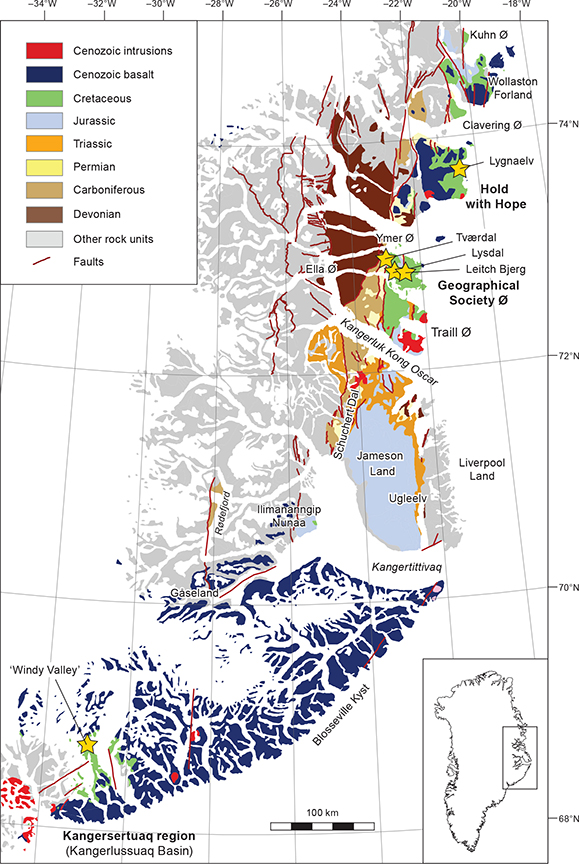
Fig. 1 Geological overview of the study area in East and North-East Greenland. Localities where Cenomanian ammonites were collected are indicated by yellow stars. From north to south, these are Lygnaelv (CASP locality no. K7359, coordinates 74.2639, –20.55, WGS84 datum); Tværdal (CASP locality no. K7350, coordinates 72.9633, –23.0667; no. K7351, coordinates 73.0003, –22.9717; no. W3099, coordinates 72.958, –23.0452); Lysdal (CASP locality no. W4389, coordinates 72.8957, –22.807; no. W4390, coordinates 72.8965, –22.8122); Leitch Bjerg (CASP locality no. W4342, coordinates 72.8555, –22.5023); and ‘Windy Valley’ (CASP locality no. W4225; coordinates: 68.6383, –30.9297).
Simon R.A. Kelly passed away in May 2023, prior to the completion of this publication. Besides collecting most of the specimens, he had cleaned and prepared the material and made initial taxonomic and biostratigraphic assessments. Recognising the scientific value of the ammonites, he initiated the study and had seen and approved the photographic work and large parts of the text before his passing. As previously agreed, Simon Schneider joined as a co-author to complete Simon Kelly’s tasks. W. James Kennedy is chiefly responsible for the taxonomic part of the study, and the new taxa take his authorship only.
2 Materials and locality details
The specimens described here were collected during several field seasons of CASP, between 1994 and 2003, and come from three regions in East and North-East Greenland (Figs 1, 2). Farthest to the north, in the Hold with Hope region, Cenomanian ammonites were found in a single locality at Lygnaelv (CASP locality no. K7359, coordinates in decimal degrees 74.2639, –20.55, World Geodetic System 1984 (WGS84) datum; Supplementary File S1; ‘HH’ in Table 1), exposing the Fosdalen Formation (Home Forland Group; Kelly et al. 1998; see Bjerager et al. 2020 for updated lithostratigraphy). The Fosdalen Formation is an over 1-km thick unit of dark mudstones with siderite concretions, intercalated with varying proportions of thin fine-grained sandstone beds (Kelly et al. 1998), and was deposited in slope to basin floor settings according to Bjerager et al. (2020). Combined biostratigraphy of dinoflagellate cysts, inoceramid bivalves, and locally ammonites, indicates a middle Albian to middle Coniacian age (between 108 and 87 Ma) for the Fosdalen Formation on Hold with Hope (Kelly et al. 1998; Bjerager et al. 2020). Of three fragmentary Cenomanian ammonites collected, two are too poorly preserved for identification; the third specimen is assigned to Schloenbachia varians forma ventriosa below.
| Species name | HH | T1 | T2 | T3 | LB | LD1 | LD2 | WV |
| Gaudryceras (Gaudryceras) cassissianum (d’Orbigny 1850) | × | × | ||||||
| Gaudryceras (Mesogaudryceras) leptonema (Sharpe 1855) | × | × | ||||||
| Parapuzosia (Austiniceras) austeni Sharpe 1855 | × | |||||||
| Phylloceras (Hypophylloceras) lombardensis (Joly 2000) | × | |||||||
| Schloenbachia varians (J. Sowerby 1817) | × | × | × | × | × | × | × | |
| Titanoleioceras boreale n. gen., n. sp. | × | |||||||
| T1–T3: Tværdal 1–3. LB: Leitch Bjerg. LD1, LD2: Lysdal 1, 2. HH: Lygnaelv, Hold with Hope. WV: ‘Windy Valley’. | ||||||||
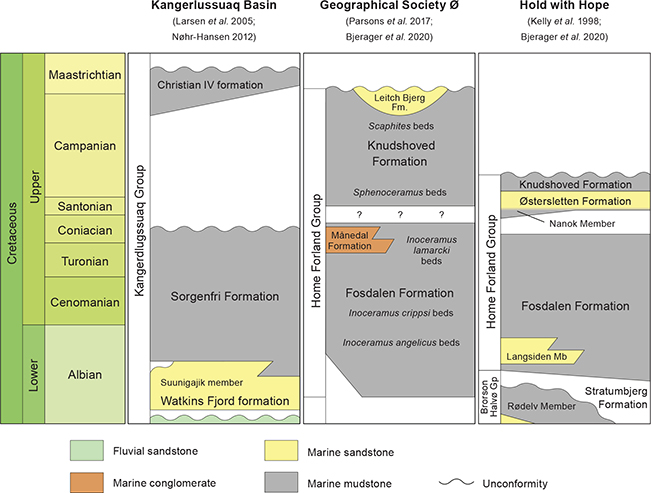
Fig. 2 Albian to Maastrichtian lithostratigraphy of the Kangerlussuaq Basin (data sources: Larsen et al. 2005; Nøhr-Hansen 2012), Geographical Society Ø (data sources: Parsons et al. 2017; Bjerger et al. 2020) and Hold with Hope (data sources: Kelly et al. 1998; Bjerger et al. 2020).
Approximately 100 km farther south, six localities on Geographical Society Ø also exposing the Fosdalen Formation, yielded ammonites (see Bjerager et al. 2020 for a revised lithostratigraphy). The Fosdalen Formation on Geographical Society Ø is thought to be of similar thickness as on Hold with Hope (cf. Bjerager et al. 2020) and represents slope to basin-floor deposits (Parsons et al. 2017). Note that Parsons et al. (2017, their supplementary materials 4) reported macrofauna including markers of early and late Albian, early and middle Cenomanian, late Turonian and Coniacian age from the Fosdalen Formation, supporting a chronostratigraphic range between 112 and 86 Ma. For the overlying Knudshoved Formation, sensu Bjerager et al. (2020), Parsons et al. (2017) reported late Santonian to early Campanian inoceramids and middle to late Campanian ammonites (indicating an age range between 84 and 70 Ma). Furthermore, Parsons et al. (2017) regarded the contact between the Fosdalen and Knudshoved Formations on Geographical Society Ø as conformable. In contrast, Bjerager et al. (2020) indicated a major hiatus encompassing the entire Coniacian and Santonian stages, but did not describe the contact of the two units on Geographical Society Ø. Thus, while the precise relationship between these two units remains unclear, the age restrictions imposed by Bjerager et al. (2020) are clearly contradicted by macrofossil evidence (Parsons et al. 2017). The lithostratigraphic column depicted in Fig. 2 represents a merger of both schemes. Cenomanian ammonites were collected from three localities in Tværdal (Fig. 1; Table 1: ‘T1’, CASP locality no. K7350, coordinates 72.9633, –23.0667; ‘T2’, CASP locality no. K7351, coordinates 73.0003, –22.9717; ‘T3’, CASP locality no. W3099, coordinates 72.958, –23.0452), two localities in Lysdal (Fig. 1; Table 1: ‘LD1’, CASP locality no. W4389, coordinates 72.8957, –22.807; ‘LD2’, CASP locality no. W4390, coordinates 72.8965, –22.8122), and a single outcrop on Leitch Bjerg (Fig. 1; Table 1: ‘LB’, CASP locality no. W4342, coordinates 72.8555, –22.5023). All but one of these localities yielded specimens of Schloenbachia varians. In addition, Gaudryceras (Gaudryceras) cassisianum and Gaudryceras (Mesogaudryceras) leptonema each occur at a single locality (Table 1).
Another 500 km farther south, in the Kangerlussuaq Basin, ammonites occur in the Sorgenfri Formation, an up to c. 140 m thick unit of sandy mudstones with characteristic dark, phosphatic concretions, rare discrete sandstone beds, and occasional calcareous concretions and concretionary horizons (Larsen et al. 2005). Sedimentology suggests deposition in a mid- to outer shelf setting (Larsen et al. 2005). A middle Albian to middle Coniacian age (between 108 and 87 Ma) is indicated by combined ammonite and dinoflagellate cyst biostratigraphy (Larsen et al. 2005). Ammonites were collected from a single outcrop in ‘Windy Valley’ (CASP locality no. W4225, coordinates: 68.6383, –30.9297 WGS84 datum), where the Sorgenfri Formation is more than 95 m thick (Fig. 3), consisting of mudstone with sparse bioturbation throughout, and concretions occuring in the lower 30 m of the succession. This locality has produced the richest and most diverse ammonite assemblage of Cenomanian age, including all six species described herein. Ammonites occur scattered within the lower 60 m of the exposure (Fig. 3), but most specimens were collected loose from the base of the outcrop. Based on the few specimens collected in situ, there is no apparent zonation. ‘Windy Valley’ is the type locality of Titanoleioceras boreale gen. et sp. nov.
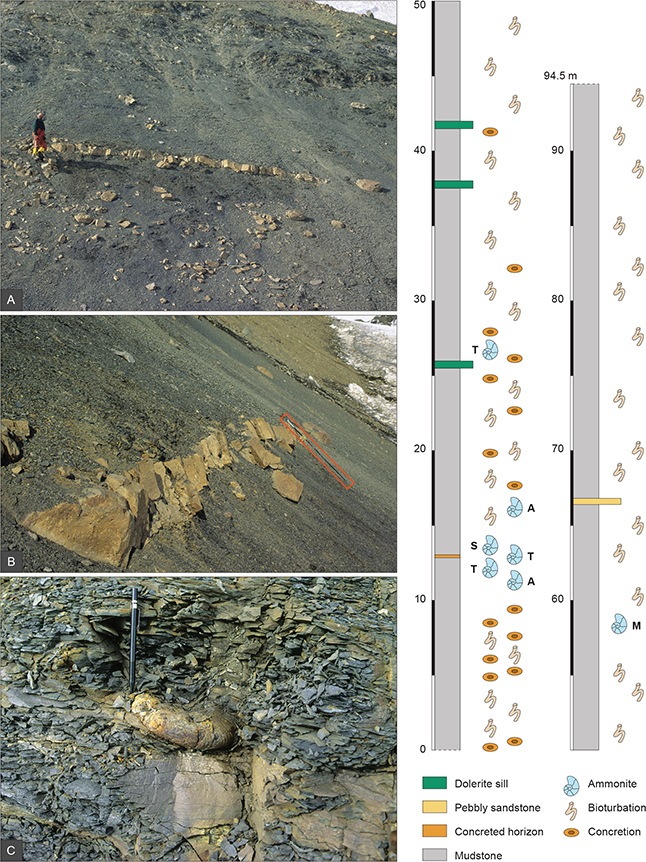
Fig. 3 Photographs and schematic log of CASP locality no. W4225, ‘Windy Valley’, Kangerlussuaq Basin. A: Upper half of exposure, with prominent, yellowish pebbly sandstone bed at 67 m log height (person for scale). B: Close-up view along pebbly sandstone bed at 67 m log height (1.5 m walking pole for scale). C: Ammonite Parapuzosia (Austiniceras) austeni (Sharpe 1855) in situ in fissile shale at approximately 12 m log height (MGUH 34452; pencil for scale). Original log and all photographs by A.G. Whitham (CASP). Abbreviations: A: Parapuzosia (Austiniceras) austeni. M: Gaudryceras (Mesogaudryceras) leptonema. S: Schloenbachia varians. T: Titanoleioceras boreale.
Generally, it should be noted that only the best-preserved, most representative specimens are included in this study. Numerous additional Cenomanian ammonite specimens collected by CASP are either too poorly preserved to be diagnostic or are more fragmentary representatives of the taxa described below (particularly Schloenbachia).
All specimens from Greenland that are figured and discussed in this study are curated at the Natural History Museum of Denmark, Copenhagen, Denmark, under accession numbers MGUH 34448–34490 and GM 2024.2–2024.14. This published work and the nomenclatural acts it contains have been registered in ZooBank: http://zoobank.org/urn:lsid:zoobank.org:pub:4F83504A-7C33-418D-B812-04DC558F16E4
3 Discussion: age and composition of the faunas
The widespread occurrence of the genus Schloenbachia, identified as the early Cenomanian Schloenbachia varians (J. Sowerby 1817), confirms the horizon of the ammonites described below. This species dominates the overall assemblage and is a classic Boreal indicator, extending from North-East Greenland eastwards on the north side of Tethys to Iran north of the Zagros and western Kazakhstan (Fig. 4; Wilmsen & Mosavinia 2010, fig. 2; Kennedy 2013, text-fig. 1). Records from Algeria on the south side of Tethys (Kennedy & Juignet 1984, p. 123; Mendir et al. 2019, p. 239, plate 1, fig. 3) are based on poorly preserved Acompsoceras Hyatt 1903, in our view. Of other species present, Parapuzosia (Austiniceras) austeni (Sharpe 1855) was previously known from the Cenomanian and Turonian, ranging from southern England to France, Germany, the Czech Republic, Ukraine (Crimea), and, perhaps, KwaZulu-Natal in South Africa (Wright & Kennedy 1984, p. 60). Most remarkable is the diversity, albeit in small numbers of specimens, of what are generally regarded as classic Tethyan genera that are rare in the Boreal faunas of Europe: Phylloceras (Hypophylloceras) Salfeld 1924, Gaudryceras (Gaudryceras) de Grossouvre 1894, and G. (Mesogaudryceras) Spath 1927. The giant Titanoleioceras gen nov. is believed to have its origins in the typically Tethyan Tetragonitinae. In contrast, cosmopolitan members of the Acanthoceratoidea, which provide zonal indices for the Cenomanian of the Eurasian part of the Boreal Realm, are absent, as are heteromorphs.
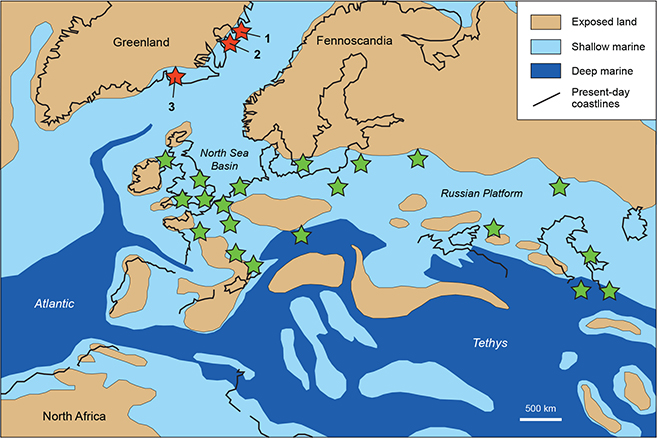
Fig. 4 Simplified early Cenomanian (100.5–95.7 Ma) palaeogeography of Europe and adjacent regions. Some partial present-day coastlines are given for orientation where appropriate. Occurrences of Schloenbachia varians are marked by stars – those reported herein in red (1: Hold with Hope. 2: Geographical Society Ø. 3: Kangerlussuaq Basin), previously published sites in green. Map modified from Wilmsen & Mosavinia (2010) and Kennedy (2013).
In lower Cenomanian successions, such as those in the West Melbury Formation marly chalks of south-east England or the phosphatic faunas of the Glauconitic Marl in the Isle of Wight, specimens of Schloenbachia varians make up perhaps as much as 99% of the ammonite fauna. Absence of Acanthoceratoidea and heteromorphs from the much smaller collections from East and North-East Greenland may thus simply reflect collection failure. The phylloceratid, gaudryceratid, and tetragonitid occurrences are unlikely to be a record of populations in their optimum habitats. Rather, they probably represented individuals that became separated from their parent populations, and drifted, either in life or after death, to their final site of burial. Quite where those parent populations were located is unknown. Dispersal of ammonites over long distances is documented and discussed by Kennedy & Cobban (1976, p. 64; see in particular text-fig. 19). A recent example of such an occurrence even more remarkable than the present ones is the single gaudryceratid recorded from the late Cenomanian and earliest Turonian hydrothermal vent faunas of the Troodos Massif in Cyprus that formed at depths of 2500–5000 m on arc-related spreading ridges of the Neotethys (Kaim et al. 2021, p. 1942, text-fig. 5f), and interpreted as a waterlogged shell that sank from surface waters.
4 Systematic palaeontology
Conventions. Dimensions are given in mm: D: diameter. Wb: whorl breadth. Wh: whorl height. U: umbilicus. Figures given in parentheses are dimensions as a percentage of diameter. The suture terminology is that of Korn et al. (2003): E: external lobe. A: adventive lobe. U1,U2and U2: umbilical lobes. I: internal lobe. L: lateral lobe.
Order Ammonoidea Zittel 1884
Suborder Phylloceratina Arkell 1950
Superfamily Phylloceratoidea Zittel 1884
Family Phylloceratidae Zittel 1884
Subfamily Phylloceratinae Zittel 1884
Genus Phylloceras Suess 1866
Type species. Ammonites heterophyllus J. Sowerby 1820, p. 119, plate 26, by monotypy.
Subgenus Phylloceras (Hypophylloceras) Salfeld 1924
Type species. Phylloceras onoense Stanton 1895, p. 74, by monotypy.
Phylloceras (Hypophylloceras) lombardensis (Joly 2000)
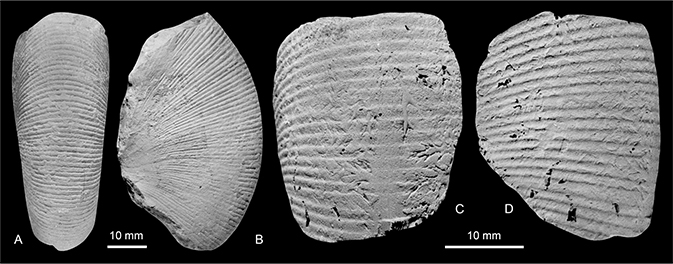
Fig. 5 Phylloceras (Hypophylloceras) lombardense (Joly 2000). A, B: MGUH 34489. C, D: MGUH 34452; both from CASP locality W4225, ‘Windy Valley’, Kangerlussuaq. A, B are ×2; C, D are ×1.
| ?1954 | Phylloceras cf. velledae (Michelin); Donovan, p. 5. |
| 2000 | Hyporbulites lombardensis Joly, p. 163, plate 39, fig. 11; text-fig. 387. |
| 2009 | Hyporbulites lombardensis Joly 2000; Klein et al. pp. 90, 92. |
Type. The holotype, by original designation, is in the B. Joly Collection (presumably in private hands; no repository given) and is from the condensed lower and middle Cenomanian Banc des Lombards, Cassis, Bouches-du-Rhône, France.
Material. MGUH 34489 and MGUH 34467 from CASP locality W4225, ‘Windy Valley’, Kangerlussuaq Basin.
Description. MGUH 34489 (Figs 5A, B) is a 120° sector of phragmocone retaining traces of recrystallised shell, with a maximum preserved whorl height of 39 mm. Coiling is very involute, the tiny umbilicus with a convex, outward-inclined umbilical wall and rounded umbilical shoulder. The whorl section is compressed subrectangular, with a whorl breadth to height ratio of 0.64, the greatest breadth just outside the umbilical shoulder. The flanks are flattened and subparallel, converging ventrally. The ventrolateral shoulders are broadly rounded, the venter feebly convex. Delicate riblets arise as mere striae on the umbilical wall, and strengthen across the umbilical shoulder, where they are grouped in bundles. The riblets are very feebly convex across the umbilical shoulders, prorsiradiate and near straight on the flanks, flexing very feebly forwards to cross the venter in the feeblest of convexities. MGUH 34467 (Figs 5C, D) is a much larger internal mould fragment of the outermost flank, ventrolateral shoulder, and venter of a phragmocone. The riblets are very feebly prorsiradiate on the flanks and ventrolateral shoulder, and near-transverse over the venter.
Discussion. These specimens are referred to P. (H.) lombardensis on the basis of whorl section and ornament, with the riblets tending to arise in bunches from the umbilical shoulder.
Occurrence. Condensed lower or middle Cenomanian of Cassis, Bouches-du-Rhône, France, and East Greenland.
Suborder Lytoceratina Hyatt 1889
Superfamily Tetragonitoidea Hyatt 1900
Family Gaudryceratidae Spath 1927
Genus and Subgenus Gaudryceras de Grossouvre 1894
Type species. Ammonites mitis Hauer 1866, p. 305, plate 2, figs 3, 4, by the subsequent designation of Boule et al. 1906, p. 183(11).
Gaudryceras (Gaudryceras) cassisianum (d’Orbigny 1850)
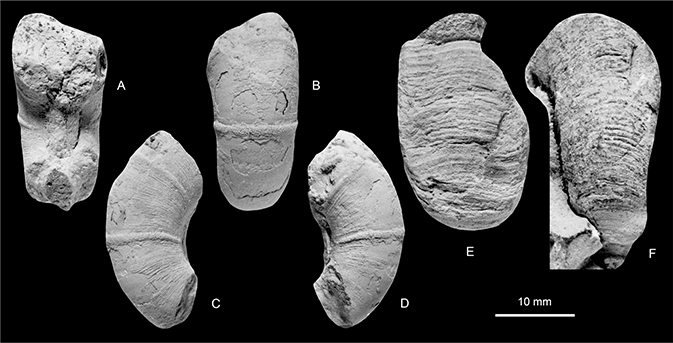
Fig. 6 Gaudryceras (Gaudryceras) cassisianum (d’Orbigny 1850). A–D: MGUH 34449, CASP locality no. W4225, ‘Windy Valley’, Kangerlussuaq. E, F: MGUH 34483, CASP locality no. K7351, Tvaerdal, Geographical Society Ø. All ×2.
| 1850 | Ammonites cassisianus d’Orbigny 1850, p. 146. |
| 1940 | Gaudryceras cassisianum d’Orbigny sp.; Fabre, p. 216, plate 5, figs 8, 9. |
| ?1954 | Gaudryceras sp. indet. Donovan, p. 7, plate 2, fig. 3. |
| 1955 | Ammonites (Gaudryceras) cassisianus d’Orbigny; Sornay, fiche 25, figs 1–3. |
| 1978 | Anagaudryceras cf. cassisianum (d’Orbigny 1850); Cooper, p. 65, fig. 8, non figs 9, 10, 11b-d. |
| ?1980 | Anagaudryceras cf. cassisianum (d’Orbigny 1850); Marcinowski, p. 243, plate 1, fig. 13. |
| 1987 | Gaudryceras cenomanense Thomel, p. 3, plate 1, fig. 6. |
| 1992 | Gaudryceras cenomanense Thomel; Thomel, plate 7, figs 6–9; text-fig. 30h. |
| 1994 | Gaudryceras (Gaudryceras) cassisianum (d’Orbigny 1850); Kennedy, p. 218, plate 2, figs 8, 9; plate 3, figs 9–13, 15, 16, 18, 19, 24; plate 12, fig. 13. |
| 2009 | Gaudryceras cassisianum (d’Orbigny 1850); Klein et al. pp. 172, 175 (with additional synonymy). |
Types. The lectotype, by the subsequent designation of Sornay (1955) was refigured by Kennedy (1994, plate 3, figs 9, 10), as was the paralectotype (1994, plate 3, fig. 12). The specimens are both registered as 6122 in the d’Orbigny Collection, housed in the Muséum National d’Histoire Naturelle, Paris.
Material. Two specimens, MGUH 34449 from CASP locality W4225, ‘Windy Valley’, Kangerlussuaq Basin and MGUH 34483 from CASP locality K7351, Tværdal, Geographical Society Ø.
Description. MGUH 34449 (Fig. 6A–D) is a 120° sector of phragmocone with extensive areas of recrystallised shell preserved. Coiling is evolute, with a broad umbilicus of moderate depth. The whorl section is circular and slightly depressed. Delicate lirae and striae arise on the umbilical wall, sweep back and strengthen across the umbilical shoulder, are prorsiradiate, and very feebly sinuous across the flanks and transverse over the venter. Two strong collars are present on the fragment. They follow the course of the riblets and striae and strengthen progressively across flanks, ventrolateral shoulders, and venter.
Discussion. Kennedy (1994) described and illustrated the types and a range of topotypes that differ in no significant respects from the present specimens. Gaudryceras cenomanense Thomel 1987 (p. 3, plate 1, fig. 6) is a clear synonym.
Occurrence. The types are from the condensed lower middle Cenomanian Banc des Lombards of Cassis, Bouches-du-Rhône, France. The species also occurs in the middle Cenomanian of Saint-Lyons, Alpes de Haute-Provence, France, and East and North-East Greenland.
Subgenus Mesogaudryceras Spath 1927
Type species. Ammonites leptonema Sharpe 1855, p. 32, plate 14, fig. 3, by the original designation of Spath (1927, p. 66).
Gaudryceras (Mesogaudryceras) leptonema (Sharpe 1855)
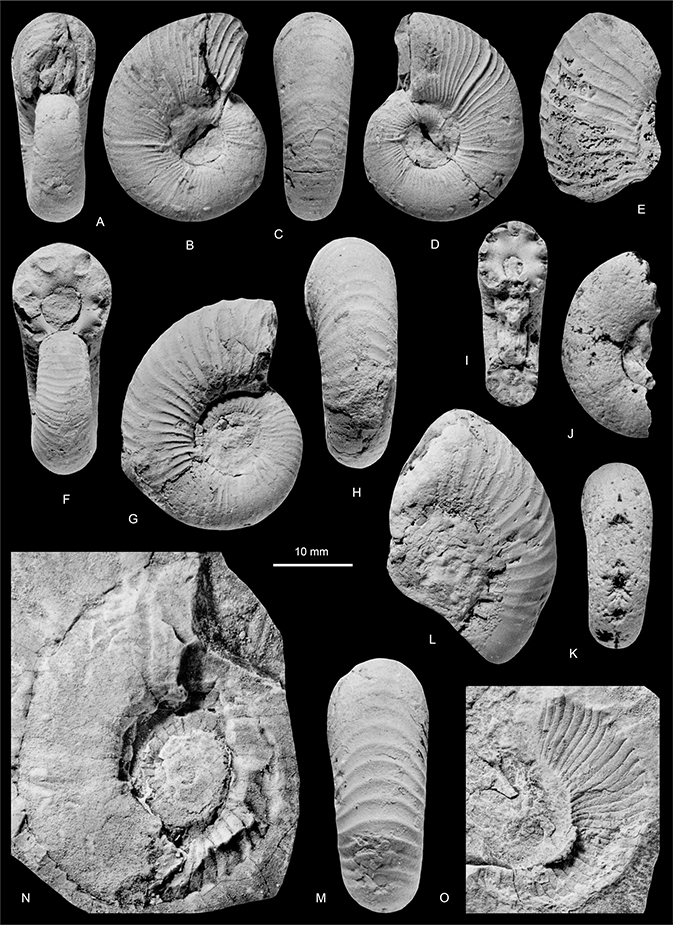
Fig. 7 Gaudryceras (Mesogaudryceras) leptonema (Sharpe 1855). A–D: MGUH 34488. E: MGUH 34466. F–H: MGUH 34457. I–K: MGUH 34487. L, M: MGUH 34448; all CASP locality no. W4225, ‘Windy Valley’, Kangerlussuaq Basin. N: MGUH 34471. O: MGUH 34472; both from CASP locality no. W4342, Leitch Bjerg, Geographical Society Ø. All ×2.
| 1855 | Ammonites leptonema Sharpe, p. 32, plate 14, fig. 3. |
| 1953 | Mesogaudryceras cf. leptonema (Sharpe); Donovan, p. 120. |
| 1954 | Mesogaudryceras cf. leptonema (Sharpe); Donovan, p. 23. |
| ?1954 | Lytoceras sp. nov. cf. vicinum H. Douvillé; Donovan, p. 6, plate 2, fig. 8. |
| 1984 | Gaudryceras (Mesogaudryceras) leptonema (Sharpe 1855); Wright & Kennedy, p. 51, plate 2, fig. 8; text-figs 3a-m (with full synonymy). |
| 1987 | Mesogaudryceras leptonema (Sharpe 1856); Thomel, p. 10, plate 1, figs 1, 5, 12; plate 2, fig. 7; plate 3, fig. 1; plate 4, fig. 7; text-figs 3, 4, 5. |
| 1992 | Mesogaudyrceras leptonema (Sharpe); Thomel, plate 7, figs 4, 5; plate 10, figs 6, 7, 9–11; text-fig. 30d, e. |
| 1994 | Gaudryceras (Mesogaudryceras) leptonema (Sharpe 1855); Kennedy, p. 218, plate 3, figs 4–8, 14, 23. |
| 1997 | Mesogaudryceras leptonema (Sharpe 1855); Arkadiev & Bogdanova, p. 110, plate 46, figs 1, 2. |
| 2000 | Mesogaudryceras leptonema (Sharpe 1855); Arkadiev et al. p. 99, plate 10, figs 1, 2 |
| 2009 | Gaudryceras leptonema (Sharpe 1855): Klein et al. pp. 171, 183. |
Type. The holotype, by monotypy, is no. 7762 in the collections of the British Geological Survey, Keyworth, from the Cenomanian Lower Chalk of Ventnor, Isle of Wight, UK, the original of Sharpe (1855, plate 14, fig. 3), refigured by Wright & Kennedy (1984, plate 2, figs 8a-c).
Material. Eight specimens, MGUH 34448, MGUH 34457, MGUH 34466, MGUH 34487, MGUH 34488, GM 2024.2, GM 2024.5 and GM 2024.6, from CASP locality W4225, ‘Windy Valley’, Kangerlussuaq, and three specimens, MGUH 34471, MGUH 34471 and GM 2024.9, from CASP locality W4342, Leitch Bjerg, Geographical Society Ø.
Description. Phragmocones are up to 30.4 mm in diameter. Coiling is evolute, the broad umbilicus comprising up to 33% of the diameter, shallow, with a convex umbilical wall and shoulder. The whorl section is circular to slightly compressed (whorl breadth to height ratios down to 0.92). Internal moulds are smooth (MGUH 34487; Fig. 7I–K). Most specimens retain a recrystallised shell, the surface of which is ornamented by wiry primary ribs that are much narrower than the interspaces. The ribs arise at the umbilical seam and strengthen across the umbilical wall (where they are markedly prorsiradiate). The ribs are prorsiradiate, strengthening progressively across the flanks, ventrolateral shoulders and venter, sinuous, feebly convex on ventrolateral shoulder and innermost flank, convex on the outer flank, sweeping forwards across the ventrolateral shoulder, and crossing the venter in a marked convexity. Fragments of body chamber associated with MGUH 34457 (Fig. 7F–H), together with GM 2024.2 (not figured), show this style of ornament extending to estimated whorl heights of up to 20 mm. In some specimens, occasional ribs are strengthened and form feeble flares (MGUH 34488: Fig. 7A–D). The septal lobe is very large (Fig. 7F, I).
Discussion. The present specimens differ in no significant respects from the holotype, and material from south-east France described by Thomel (1987, 1992), Wright & Kennedy (1984), and Kennedy (1994). Mesogaudryceras rarecostatus Balan 1979 (p. 40, fig. 2; Marcinowski 1980, p. 244, plate 1, figs 9, 10b, 11, 12), originally described from the Cenomanian of Ukraine (Crimea), is said to have more widely spaced ribs than G. (M.) leptonema, of which it may well be a synonym.
Occurrence. Lower or middle Cenomanian of southern England. Lower and middle Cenomanian of southeast France, the Bavarian Alps, middle Cenomanian of Ukraine (Crimea), Kopet Dag, Turkmenistan and East and North-East Greenland.
Family Tetragonitidae Hyatt 1900
Subfamily Tetragonitinae Hyatt 1900
Genus Titanoleioceras gen. nov.
Derivation of name. Titan (Greek), a giant, son of Uranus and Gaia; leios (Greek), smooth; keros (Greek), horn. Hence giant smooth horn.
Type species. Titanoleioceras boreale sp. nov.
Diagnosis. Giant Tetragonitinae with phragmocones up to 230 mm in diameter. Whorl section as wide as high or depressed, trapezoidal. Smooth but for growth lines and striae during early growth stages. Feeble, very widely separated constrictions appear in middle growth and are prominent on the adult body chamber; straight and prorsiradiate on the flanks, flexed back on ventrolateral shoulders and feebly concave over venter. Striations develop on the adult body chamber. Suture (Fig. 9) with irregularly trifid saddles and bifid lobes and small auxiliary saddles; septal lobe massive. Suture becomes highly subdivided at maturity.
Discussion. Titanoleioceras is interpreted as a hypermorphic giant derivative of Tetragonites, reaching a similar size to the largest species of Pseudophyllites Kossmat 1895. It differs from that genus in the persistence of constrictions to maturity: they are absent in Pseudophyllites. Takahashia Matsumoto 1984 (type species T. eurekae Matsumoto 1984, p. 33, text-fig. 1) is known from the holotype only, an individual 78 mm in diameter. It lacks constrictions and has well-developed crowded ribs that are markedly convex on the flanks.
Occurrence. Lower Cenomanian, East Greenland.
Titanoleioceras boreale gen et sp. nov.
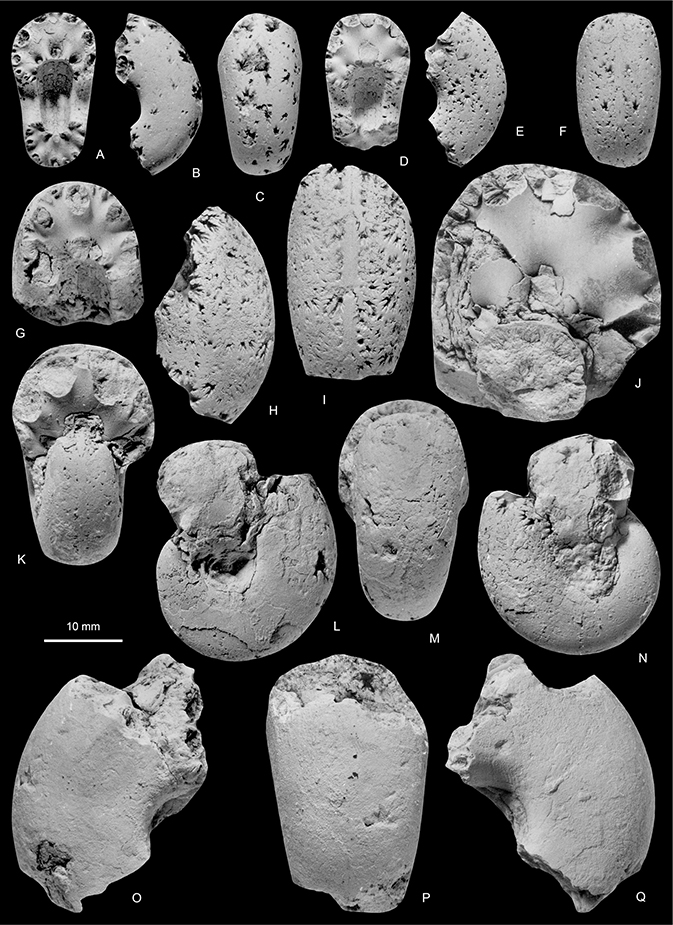
Fig. 8 Titanoleioceras boreale gen. et sp. nov. A–C: paratype, MGUH 34464. D–F: paratype, MGUH 34455. G–I: paratype, MGUH 34465. J: paratype, MGUH 34451. K–N: paratype, MGUH 34456. O–Q: paratype, MGUH 34450; all from CASP locality no. W4225, ‘Windy Valley’, Kangerlussuaq Basin. All ×2.
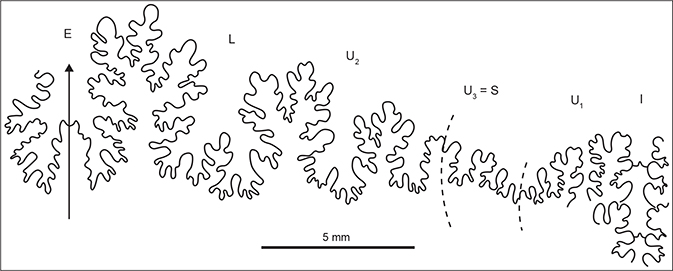
Fig. 9 Suture of a juvenile Titanoleioceras boreale gen. et sp. nov., MGUH 34455, CASP locality no. W4225, ‘Windy Valley’, Kangerlussuaq Basin. E: external lobe. A: adventive lobe. U1, U2, U3: umbilical lobes. I: internal lobe. L: lateral lobe.
Derivation of name. From boreas (Greek), north.
Types. The holotype is MGUH 34458 (Figs 10–12). There are nine paratypes, MGUH 34450, MGUH 34451, MGUH 34454, MGUH 34455, MGUH 34456, MGUH 34459, and MGUH 34463–34465.
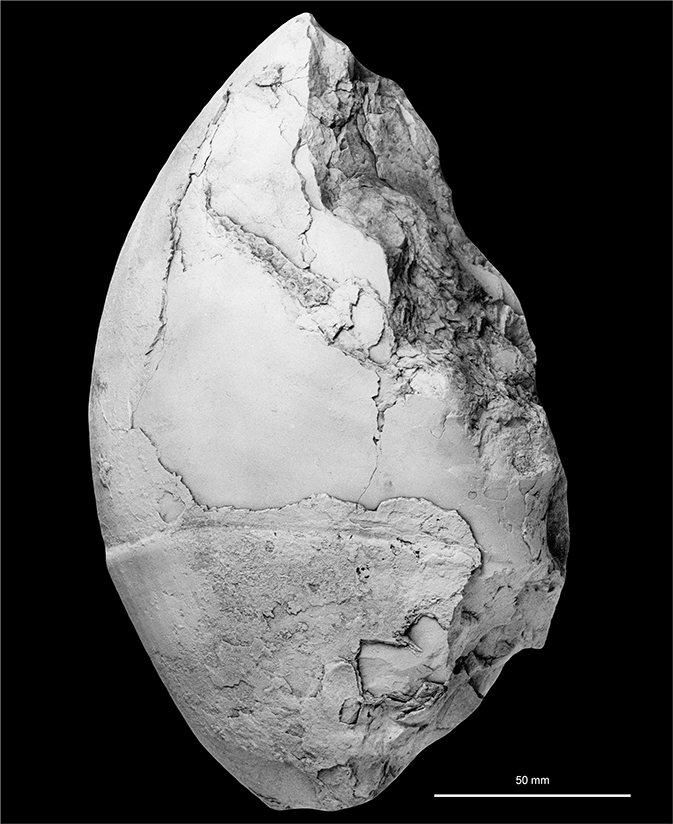
Fig. 10 Titanoleioceras boreale gen. et sp. nov., holotype, MGUH 34458, CASP locality no. W4225, ‘Windy Valley’, Kangerlussuaq Basin; ×1.
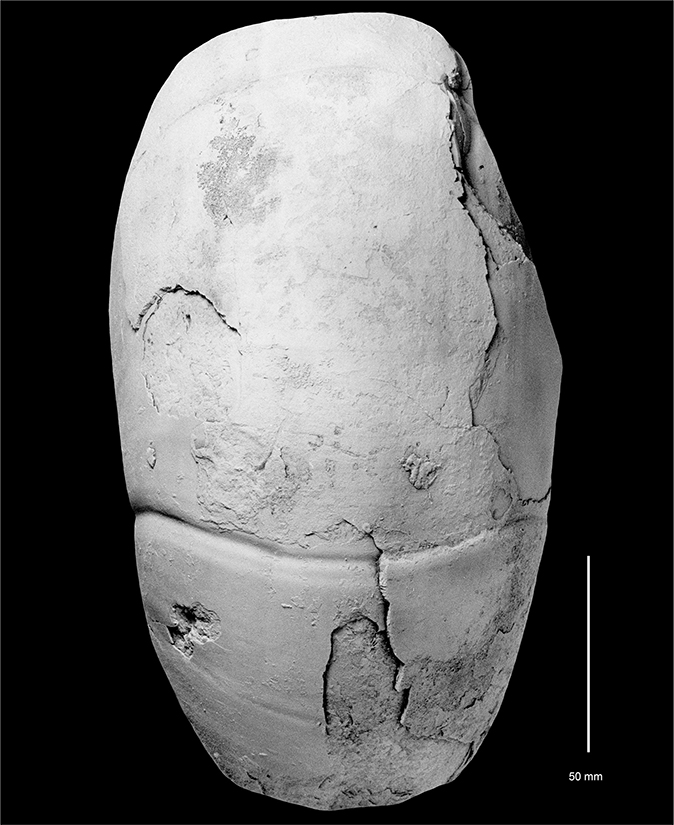
Fig. 11 Titanoleioceras boreale gen. et sp. nov., holotype, MGUH 34458, CASP locality no. W4225, ‘Windy Valley’, Kangerlussuaq Basin; ×1.
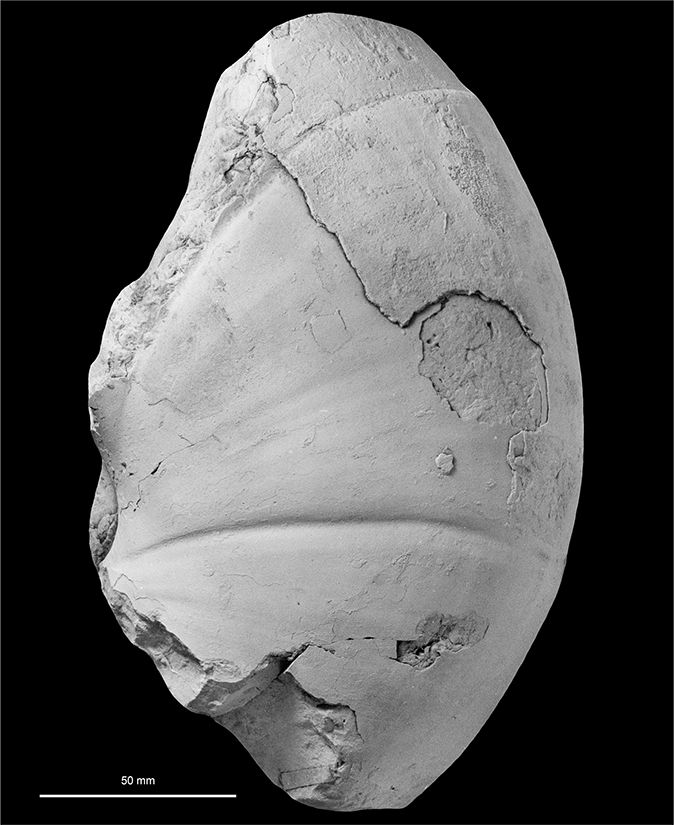
Fig. 12 Titanoleioceras boreale gen. et sp. nov., holotype, MGUH 34458, CASP locality no. W4225, ‘Windy Valley’, Kangerlussuaq; ×1.
Type locality and horizon. All specimens are from the CASP locality W4225, ‘Windy Valley’, Kangerlussuaq Basin (coordinates: 68.6383, –30.9297 WGS84 datum), from the Sorgenfri Formation. Several specimens of Titanoleioceras boreale occur below and above a horizon that yielded Schloenbachia varians, which confirms their early Cenomanian age (Fig. 3). However, most specimens were collected from scree at the base of the section.
Diagnosis. With the characters of the genus.
Dimensions. Measurements on four paratypes (MGUH 34465, MGUH 34455, MGUH 34456, and MGUH 34454) are shown here. Numbers in parentheses are dimensions as a percentage of diameter.
| MGUH no. | D | Wb | Wh | Wb:Wh | U |
| MGUH 34465 | - (-) | 11.2 (-) | 9.7 (-) | 1.15 | - (-) |
| MGUH 34455 | - (-) | 20.5 (-) | 20.5 (-) | 1.0 | - (-) |
| MGUH 34456 | 27.5 (100) | 17.6 (64.0) | 15.4 (56.0) | 1.14 | 4.5 (16.4) |
| MGUH 34454 | 225.0 (100) | 133.0 (59.1) | 130.3 (57.8) | 1.02 | 29.5 (13.1) |
| D, Wb, Wh, U in mm.-: not measurable | |||||
Description. A series of juveniles have whorl heights of up to 25 mm. Coiling is very involute, the umbilicus deep, with a flat, outward-inclined wall, and relatively narrowly rounded umbilical shoulder. The whorl section is as broad as high to slightly depressed (whorl breadth to height ratios of up to 1.15), with flattened, convergent flanks, broadly rounded ventrolateral shoulders, and a broad, feebly convex venter (Figs 8A–Q). The surface of the internal mould is smooth. The penultimate whorl of the holotype retains traces of replaced shell, with an ornament of prorsiradiate growth lines and striae only on the flanks. There is a single feeble constriction on the 180° sector of whorl, prorsiradiate on the flanks, flexing back and feebly convex across the ventrolateral shoulders, and very feebly concave over the venter. Paratype MGUH 34454 (Figs 15, 16) is a phragmocone 225 mm in diameter. The penultimate whorl is smooth. The outer whorl of the specimen bears a subdued ornament of low, effaced strigations, most obvious on the venter, and low narrow undulations on the outer flanks and venter. Paratype MGUH 34459 (Figs 13, 14) is a half whorl 240 mm in diameter, with a single feeble constriction towards the adapertural end. The outer whorl of the holotype (Figs 10–12) is a 120° sector from the adapical end of the adult body chamber. Two prominent constrictions are present, one towards the adapical end, the other at the adapertural end. They are very feebly concave on the umbilical wall, prorsiradiate on the flanks, across which they broaden and deepen, flex back, and are feebly convex on the ventrolateral shoulder and cross the venter in a very feeble convexity. Growth lines and shallow grooves parallel the constrictions, and feeble strigations are present, most conspicuous on the ventrolateral shoulders and venter where the shell is preserved but effaced on the internal mould.
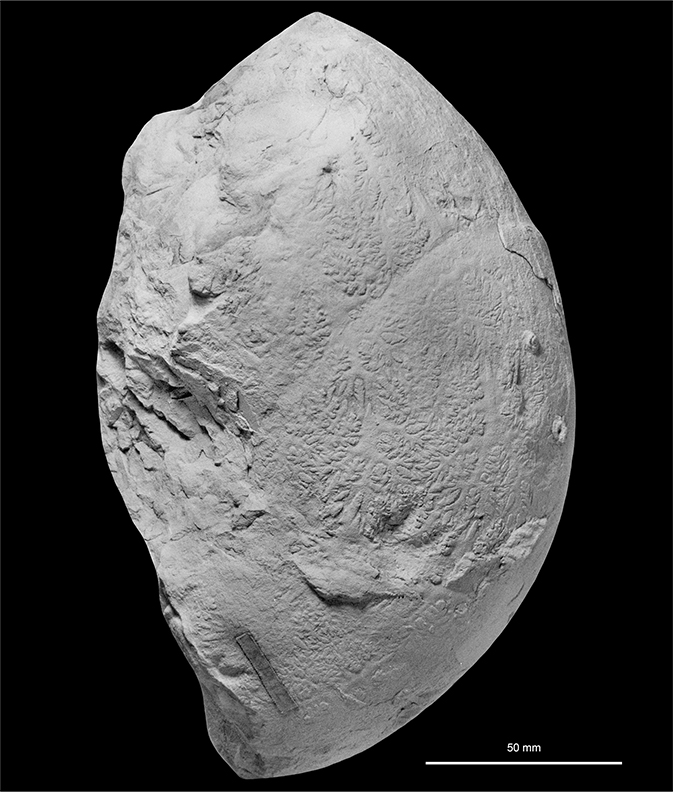
Fig. 13 Titanoleioceras boreale gen. et sp. nov., paratype, MGUH 34459, CASP locality no. W4225, ‘Windy Valley’, Kangerlussuaq; ×1.
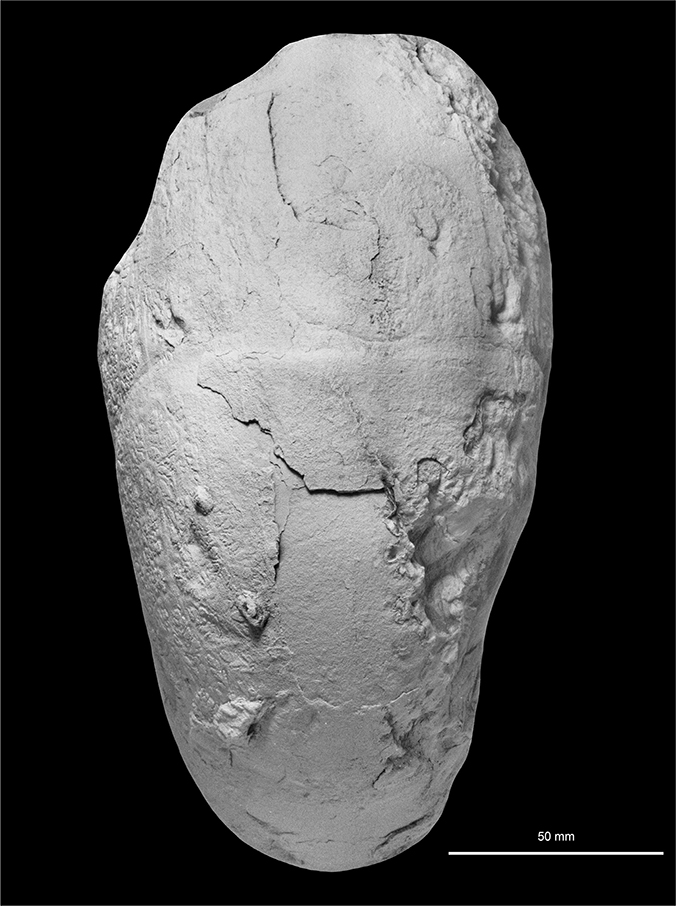
Fig. 14 Titanoleioceras boreale gen. et sp. nov., paratype, MGUH 34459, CASP locality no. W4225, ‘Windy Valley’, Kangerlussuaq Basin; ×1.
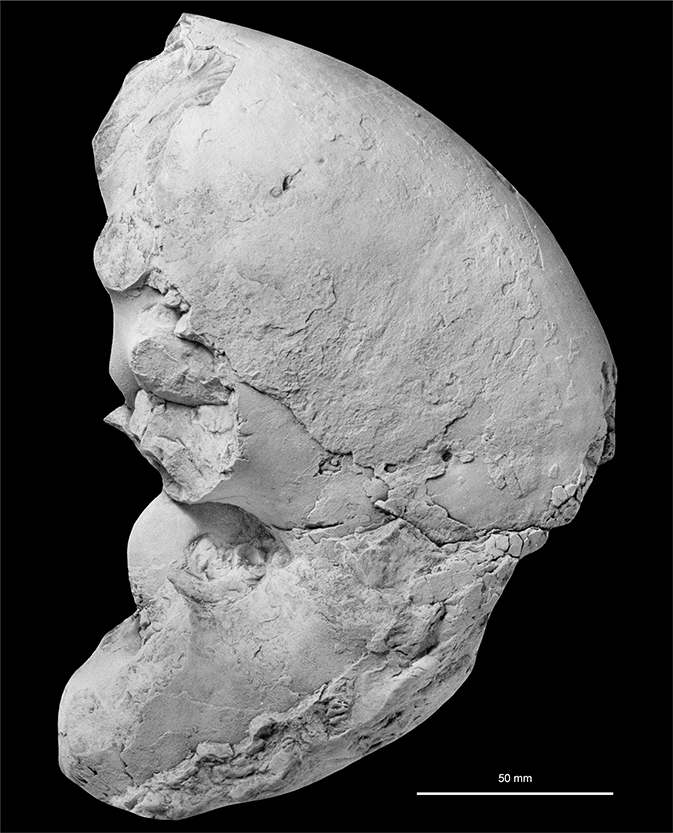
Fig. 15 Titanoleioceras boreale gen. et sp. nov., paratype, MGUH 34454, CASP locality no. W4225, ‘Windy Valley’, Kangerlussuaq Basin; ×1.
The suture is described in the diagnosis for the genus.
Discussion. Differences from species of Pseudophyllites Kossmat 1895 and Takahashia Matsumoto 1984, are discussed with the genus.
Occurrence. As for genus.
Suborder Ammonitina Hyatt 1889
Superfamily Desmoceratoidea Zittel 1895
Family Desmoceratidae Zittel 1895
Subfamily Puzosiinae Spath 1922
Genus Parapuzosia Nowak 1913
Type species. Sonneratia daubréei Grossouvre 1894, p. 154, plate 28; by original designation.
Subgenus Parapuzosia (Austiniceras) Spath 1922
Type species. Ammonites austeni Sharpe 1855, p. 28, plate 12, fig. 1; by original designation by Spath (1922, p. 127).
Parapuzosia (Austiniceras) austeni Sharpe 1855
Figs 17A–E, 18A–D, 19A, B, 20
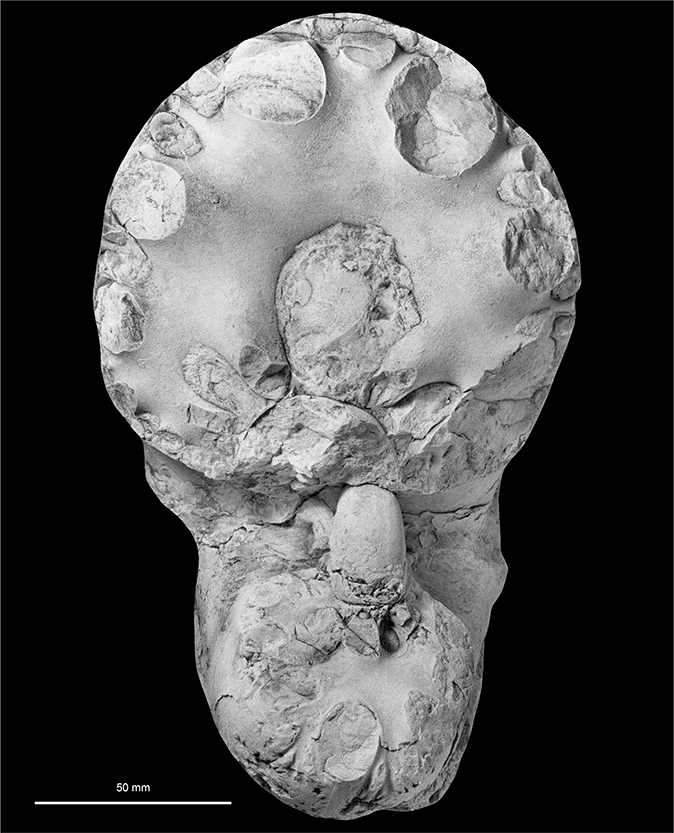
Fig. 16 Titanoleioceras boreale gen. et sp. nov., paratype, MGUH 34454, CASP locality no. W4225, ‘Windy Valley’, Kangerlussuaq; ×1.
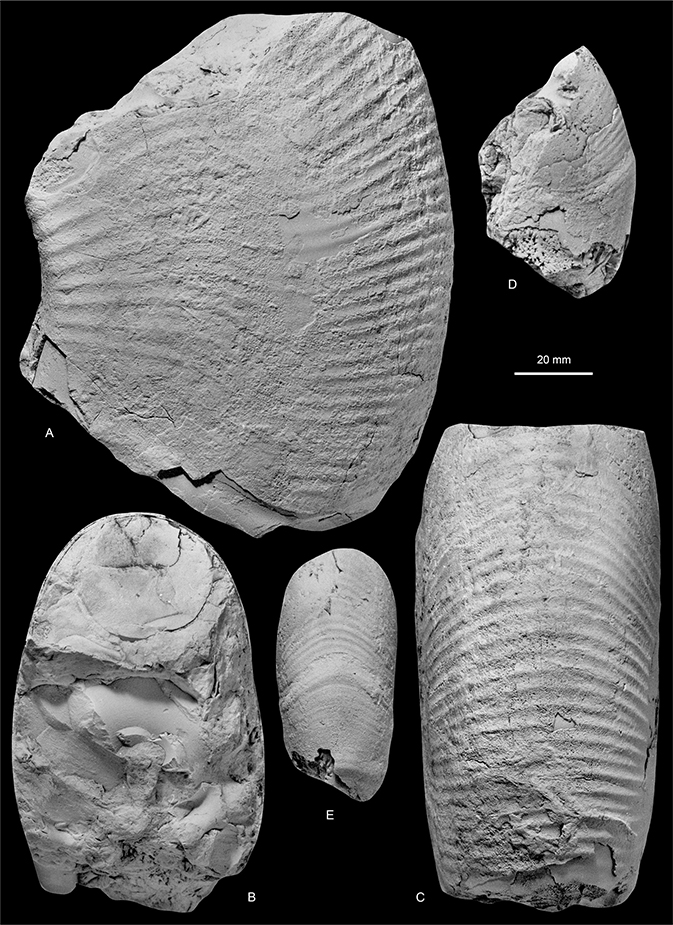
Fig. 17 Parapuzosia (Austiniceras) austeni (Sharpe 1855). A–C: MGUH 34460. D, E: MGUH 34461; both from CASP locality no. W4225, ‘Windy Valley’, Kangerlussuaq Basin; ×1.
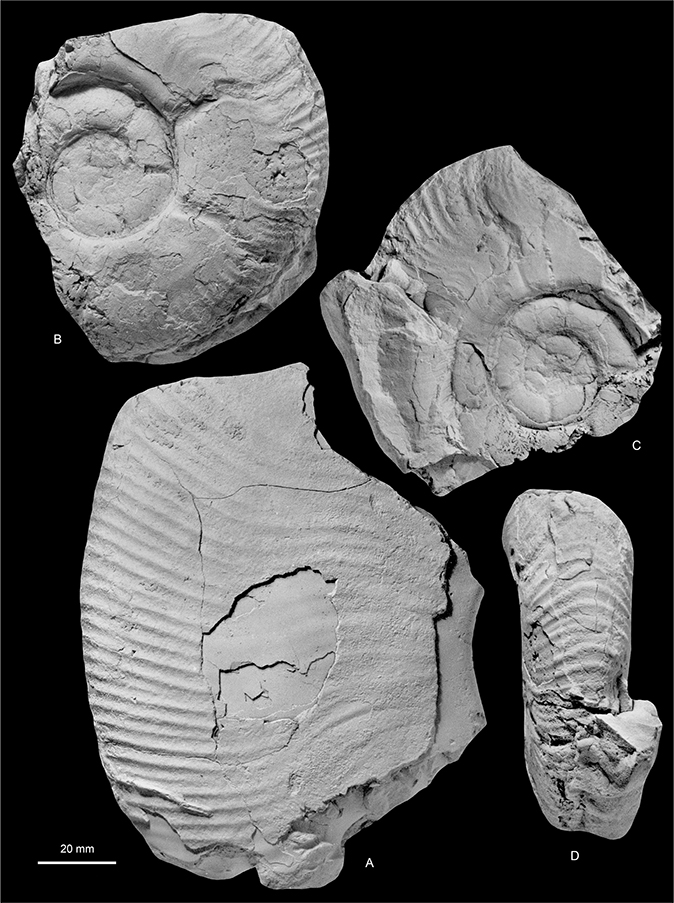
Fig. 18 Parapuzosia (Austiniceras) austeni (Sharpe 1855). A: MGUH 34460. B–D: MGUH 34462; both from CASP locality no. W4225, ‘Windy Valley’, Kangerlussuaq Basin; ×1.
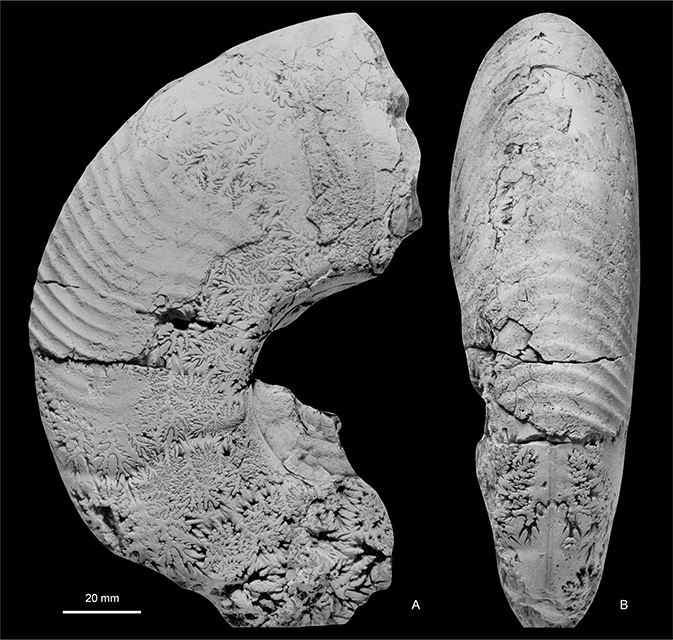
Fig. 19 Parapuzosia (Austiniceras) austeni (Sharpe 1855). A, B: MGUH 34452, CASP locality no. W4225, ‘Windy Valley’, Kangerlussuaq Basin; ×1.
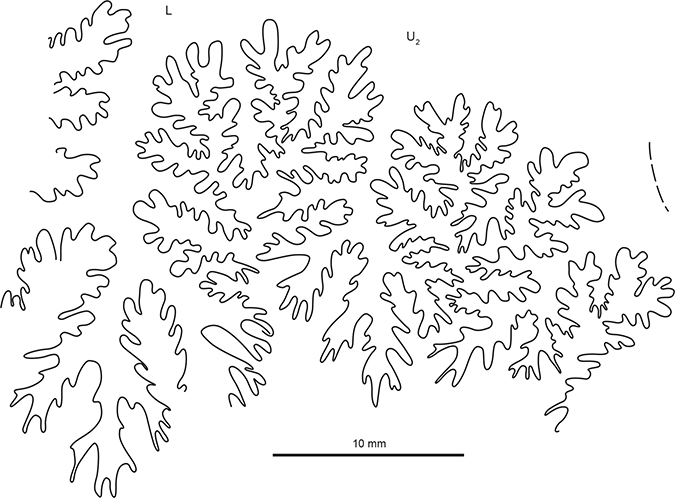
Fig. 20 Partial external suture of Parapuzosia (Austiniceras) austeni (Sharpe 1855), MGUH 34452, CASP locality no. W4225, ‘Windy Valley’, Kangerlussuaq Basin. L: lateral lobe. U2: umbilical lobe.
| 1855 | Ammonites austeni Sharpe, p. 28, plate 12, fig. 1, non 2 [= Puzosia (Anapuzosia) dibleyi (Spath 1922)]. |
| 1984 | Parapuzosia (Austiniceras) austeni (Sharpe 1855); Wright & Kennedy, p. 60, plate 5,figs 3, 6; text-fig. 5 (with full synonymy). |
| 1987 | Parapuzosia (Austiniceras) austeni (Sharpe); Wright & Kennedy, p. 144, text-fig. 7.1. |
| non 1992 | Parapuzosia (Austiniceras) austeni (Sharpe); Thomel, p. 209, plate 82 [= Puzosia (Anapuzosia) sp.]. |
| 1998 | Parapuzosia (Austiniceras) austeni (Sharpe 1855); Kaplan et al. p. 78, plate 1, figs 4, 7, 9; plate 2; plate 4. |
Types. The lectotype, designated by Spath (1922, p. 127) is C3382 in the collections of the Natural History Museum, London, from the Lower Chalk of Guildford, Surrey; it is the original of Sharpe 1855, plate 12, figs1a, b. Paralectotypes have not been traced.
Material. Seven specimens, MGUH 34452, MGUH 34460, MGUH 34461, MGUH 34462, GM 2024.3, GM 2024.4, and GM 2024.7 from CASP locality W4225, ‘Windy Valley’, Kangerlussuaq.
Description. MGUH 34462 (Fig. 18B–D) may be a microconch phragmocone with an original estimated diameter of 100–110 mm, retaining traces of recrystallised shell. Coiling is evolute, with 48% of the previous whorl covered, the umbilicus broad, shallow, with a low, feebly convex wall, and narrowly rounded umbilical shoulder. The whorl section is compressed, with a whorl breadth to height ratio of 0.7. The greatest breadth is below mid-flank. The inner flanks are flattened, the middle and outer flanks feebly convex, converging to broadly arched ventrolateral shoulders and venter. There appear to be as many as eight constrictions on the inner flanks of the penultimate whorl. These are narrow, straight, and feebly prorsiradiate, with no other ornament on the surface of the intervening internal mould. On the outer whorl of the specimen, there are three constrictions per half whorl, deeply incised into the umbilical wall, strong and narrow on the flanks, straight and prorsiradiate on the inner flank, flexing back at mid-flank, feebly concave on the outer flank, sweeping forward across the ventrolateral shoulders, and crossing the venter in an obtuse linguoid peak. The adapical edge of the constrictions is strengthened into a feeble collar-rib. There are up to 16 ribs between successive constrictions. These parallel the constrictions, arising as mere striae on the inner flank, but strengthening on outer flanks, ventrolateral shoulders and venter, which bear an ornament of crowded, even, rounded ribs that are concave on outer flanks and ventrolateral shoulder and cross the venter in a rounded linguoid peak. At the adapertural end of the specimen, the last constriction and succeeding ribs modify their course, projecting strongly forward on the inner flank and back at mid-flank, to define the beginnings of lateral lappets (Fig. 18B). Traces of a further 240° of body chamber are preserved (Fig. 18C). MGUH 34461 (Fig. 17D, E) is a well-preserved phragmocone fragment with recrystallised shell preserved; the maximum preserved whorl height is 42 mm. The whorl breadth to height ratio is 0.74, the inner flanks are feebly convex and subparallel, the middle and outer flanks converging to the broadly rounded venter. Parts of two flared ribs are preserved, marking the adapical edge of constrictions on the internal mould. These collars are well-developed on the outer flanks, ventrolateral shoulders and venter, which they cross in an obtuse linguoid peak. Ornament is reduced to growth lines, striae, and riblets between the collars. There are fine, even riblets on outer flanks, ventrolateral shoulders and venter on the adapertural end of the fragment, following a narrow, smooth zone associated with the site of the adapertural of the two constrictions. GM 2024.3 (not figured) is a corroded phragmocone fragment with a maximum preserved whorl height of around 70 mm; it overlaps in size with MGUH 34452 (Figs 19A, B), a wholly septate fragment with traces of recrystallised shell preserved and the following approximate dimensions: D = 160(100); Wb = 49.8(31.1); Wh = 71.4(44.6); Wb:Wh = 0.7; U = 48.7(30.4). The umbilicus is shallow, with a flattened, outward-inclined wall and very narrowly rounded umbilical shoulder. The flanks are flattened and subparallel, the ventrolateral shoulders and venter broadly rounded. There are two constrictions, and possibly a third at the adapical end. These are conspicuous on the internal mould, straight and feebly prorsiradiate on the inner flank, flexing back and concave at mid-flank, markedly concave on the outer flank, projecting forwards on the ventrolateral shoulders and effacing markedly on the venter, where they form an obtuse chevron. Ornament is very subdued on the internal mould. Where recrystallised shell is preserved, there is a strong adapical collar rib preserved, associated with the adapertural constriction. The shell surface between constrictions or collars is ornamented by more than 30 crowded, even ribs. These are straight, prorsiradiate, and weak on the inner flanks, flexing back and convex at mid-flank, strengthening and concave on the outer flank, and broadly convex and at their maximum strength over the venter. GM 2024.4 and GM 2024.7 (not figured) are small fragments of similar-sized individuals. MGUH 34460 (Figs 17A–C, 18A) is a further phragmocone fragment, with a maximum preserved whorl height of 110 mm. The whorl breadth to height ratio is 0.67. The umbilicus is shallow, the umbilical wall flattened and inclined outwards. The umbilical shoulder is very narrowly rounded, and sharply defined. The inner to middle flank region is feebly convex, the outer flanks convergent, the ventrolateral shoulders broadly rounded, the venter very feebly convex (Fig. 17B). The surface of the recrystallised shell is ornamented by crowded even ribs. These arise on the umbilical shoulder. They are straight and feebly prorsiradiate on the inner flank, flexed back and feebly convex at mid-flank, flexing back, and concave on the outer flanks. Additional short ribs intercalate on the outermost flanks, and all ribs strengthen and sweep forwards on the ventrolateral shoulders and cross the venter in a very broad convexity.
The suture (Figs 19A, 20) is deeply and intricately subdivided, with a strongly retracted suspensive lobe.
Discussion. See Wright & Kennedy (1984, p. 60).
Occurrence. Lower Cenomanian to middle Turonian. The geographic distribution extends from southern England to Germany, France, The Czech Republic, Ukraine (Crimea), East Greenland, and perhaps KwaZulu-Natal (South Africa).
Superfamily Hoplitoidea H. Douvillé 1890
Family Schloenbachiidae Parona & Bonarelli 1897
Genus Schloenbachia Neumayr 1875
Type species. Ammonites varians J. Sowerby 1817, p. 169, plate 176, by the subsequent designation of H. Douvillé 1890, p. 200.
Schloenbachia varians (J. Sowerby 1817)
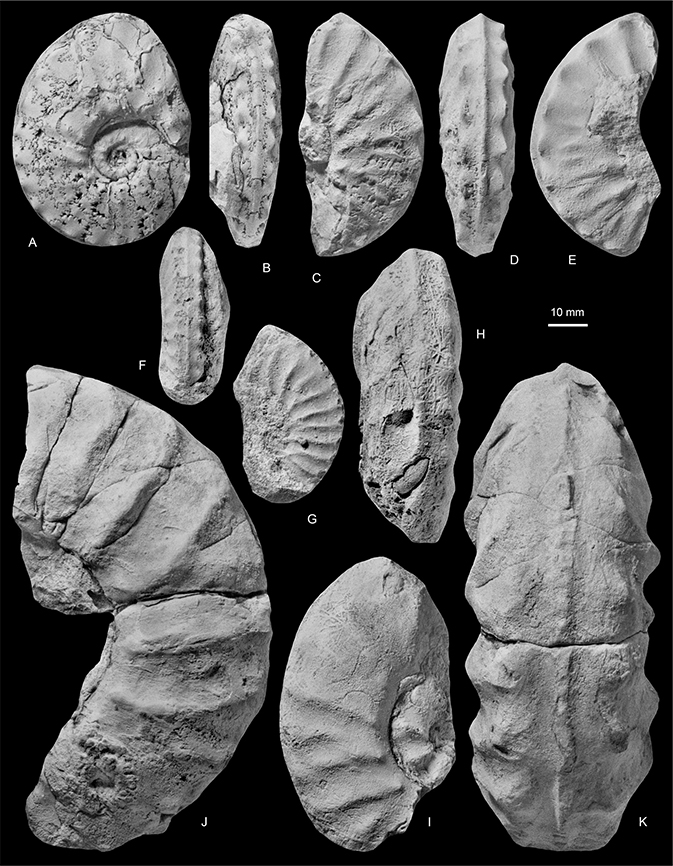
Fig. 21 Schloenbachia varians (J. Sowerby 1817). A, B: MGUH 34453, CASP locality no. W4225, ‘Windy Valley’, Kangerlussuaq Basin. C–E: MGUH 34485. F, G: MGUH 34484; both from CASP locality no. W3099, Tvaerdal, Geographical Society Ø. H, I: MGUH 34482, CASP locality no. K7350, Tvaerdal, Geographical Society Ø. J, K: MGUH 34490, CASP locality no. W3099, Tvaerdal, Geographical Society Ø. All ×1.
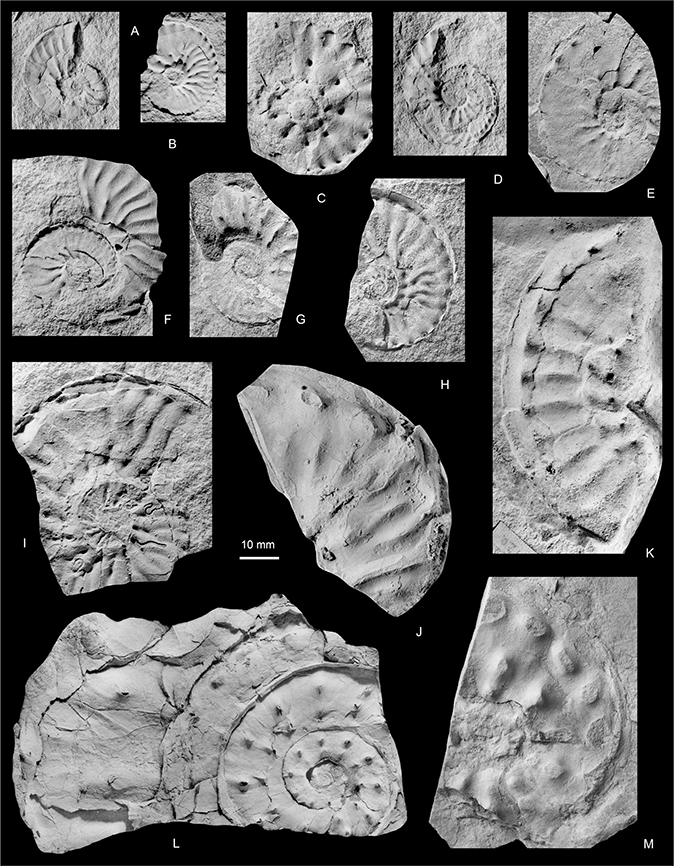
Fig. 22 Schloenbachia varians (J. Sowerby 1817). A: MGUH 34479. B: MGUH 34475; both CASP locality no. W4390, Lysdal, Geographical Society Ø. C: MGUH 34473, CASP locality no. W4389, Lysdal, Geographical Society Ø. D: MGUH 34477, CASP locality no. W4390, Lysdal, Geographical Society Ø. E: MGUH 34469, CASP locality no. W4342, Leitch Bjerg, Geographical Society Ø. F: MGUH 34480, CASP locality no. W4390, Lysdal, Geographical Society Ø. G: MGUH 34468, CASP locality no. W4342, Leitch Bjerg, Geographical Society Ø. H: MGUH 34476; I: MGUH 34474; both CASP locality no. W4390, Lysdal, Geographical Society Ø. J: MGUH 34470, CASP locality no. W4342, Leitch Bjerg, Geographical Society Ø. K: MGUH 34478, CASP locality no. W4390, Lysdal, Geographical Society Ø. L: MGUH 34481 (silicone squeeze taken from external mould), CASP locality no. K7350, Tværdal, Geographical Society Ø. M: MGUH 34486, CASP locality no. K7359, Lygnaelv, Hold with Hope. All ×1.
| 1817 | Ammonites varians J. Sowerby, p. 169 (pars), plate 176 uppermost figure, three figures in row below, right-hand figure in row below. |
| 1953 | Schloenbachia subvarians Spath; Donovan, p. 119. |
| 1953 | Schloenbachia subtuberculata (Sharpe); Donovan, p. 119. |
| 1953 | Schloenbachia cf. subplana (Mantell); Donovan, p. 120. |
| 1954 | Schloenbachia aff. subplana (Mantell); Donovan, p. 9. |
| 1954 | Schloenbachia subvarians Spath; Donovan, p. 10, plate 1, figs 1, 2, 6, 7; text-fig. 2. |
| 1954 | Schloenbachia cf. varians (J. Sowerby); Donovan, p. 12, plate 2, fig. 2. |
| 1954 | Schloenbachia subvarians var. tetrammata (J. de C. Sowerby); Donovan, p. 12, plate 2, fig. 1. |
| 1954 | Schloenbachia sp.; Donovan, p. 12, plate 1, fig. 5. |
| 1998 | Schloenbachia ventriosa Stieler; Kelly et al. p. 1005. |
| 2015 | Schloenbachia varians (J. Sowerby 1817); Kennedy in Wright & Kennedy, p. 419, plate 125, figs 2, 5; plates 126–135; plate 136, fig. 1; text-figs 161–163; 164b, c;165–167; 169–173 (with full synonymy). |
Type. Lectotype, by the subsequent designation of Spath (1938, p. 544), is no 43962b in the collections of the Natural History Museum, London. The original of Sowerby (1817, plate 176, top figure), refigured by Kennedy in Wright & Kennedy (2015, plate 125, fig. 2). It is from the Lower Chalk at an unknown locality in southern England.
Material. MGUH 34484, MGUH 34485, MGUH 34490, and GM 2024.10–2024.14 from CASP locality W3099, and MGUH 34481 and MGUH 34482 from CASP locality K7350, both Tværdal, Geographical Society Ø. MGUH 34453 and GM 2024.8 from CASP locality W4225, ‘Windy Valley’, Kangerlussuaq Basin. MGUH 34468–34470 from CASP locality W4342, Leitch Bjerg, Geographical Society Ø. MGUH 34473 from CASP locality W4389, and MGUH 34474–34480 from CASP locality W4390, both Lysdal, Geographical Society Ø. MGUH 34486 from CASP locality K7285, Hold with Hope.
Description. The material is highly variable, as with populations from elsewhere. The formae recognised are, from strongly to weakly ornamented, ventriosa, varians, subtuberculata, intermedia, and subplana. Compressed individuals, such as MGUH 34484 (Fig. 21F, G) and MGUH 34453 (Fig. 21A, B), have ribs that arise either singly or in pairs at the umbilical shoulder, with a very delicate umbilical tubercle and a slightly stronger inner lateral one, at which point the ribs commonly bifurcate, so that there are more ribs at the ventrolateral shoulder than at the umbilical shoulder. The ribs are straight and prorsiradiate on the innermost flank, but flex back and are feebly sinuous, feebly convex at mid-flank, and feebly concave on the outer flank. All ribs terminate in small ventral clavi on either side of the siphonal keel. These specimens correspond to the forma subvarians, although the presence of two tiny tubercles separates them from Sharpe’s specimen (1853, plate 8, fig. 7), in which respect they are transitional to forma subtuberculata. This form is well-represented by MGUH 34485 (Fig. 21C–E), a specimen 66 mm in diameter, with stronger umbilical and inner lateral tuberculation, the ribs showing a tendency to loop between lateral tubercles and ventral clavi. Other specimens of subvarians-subtuberculata type are GM 2024.8, GM 2024.10, and GM 2024.14 (not figured). GM 2024.11 (not figured) is an external mould of a crushed individual 80 mm in diameter with stronger ornaments and thus transitional between subtuberculata and the holotype of varians. MGUH 34481 (Fig. 22L) is a further very crushed macroconch of this type. The ornament is very well-preserved. On the inner whorls there are 11–12 small umbilical bullae, each linked by a low rib to large subspinose inner lateral bullae. The outer whorl is preserved to a height of 45 mm. Coarser ribbed and tuberculate still are MGUH 34482 and MGUH 34490. The former (Fig. 21H, I) may be an adult microconch. The penultimate whorl bears weak umbilical and very strong, coarse lateral tubercles, as in passage forms between formae varians and ventriosa. The fragmentary body chamber, preserved to a whorl height of 36 mm, appears to show eccentric coiling, the umbilical wall is flat and outward-inclined. Small bullae perch on the umbilical shoulder and give rise to one or a pair of prorsiradiate ribs. Lateral tubercles have effaced. MGUH 34490 (Fig. 21J, K) is a half whorl of body chamber with a maximum preserved diameter of 120 mm. Coarse bullae perch on the umbilical shoulder and give rise to coarse prorsiradiate ribs. These link to strong inner lateral bullae that give rise to one or two ribs that sweep forward and link to coarse ventrolateral clavi. These decline towards the adapical end of the specimen and are replaced by narrow, sharp, strongly prorsiradiate ribs that efface before reaching the strong siphonal keel (Fig. 21K). This specimen appears to be a near-complete adult macroconch of a variant between formae varians and ventriosa.
Discussion. Specimens of Schloenbachia dominate the Cenomanian assemblages from East and North-East Greenland, as they do throughout the Eurasian part of the Boreal realm. The present material comprises typical variants of early Cenomanian varians following the interpretation of Kennedy in Wright & Kennedy (2015, p. 408 et seq.). Thus, three successive species are recognised: Schloenbachia varians (J. Sowerby 1817), which is restricted to the lower Cenomanian; Schloenbachia coupei (Brongniart 1822) of the lower middle Cenomanian Acanthoceras rhotomagense Zone, and Schloenbachia lymensis Spath 1926, which first appears in the upper middle Cenomanian Acanthoceras rhotomagense Zone and has its acme in the lower upper Cenomanian Calycoceras (Proeucalycoceras) guerangeri Zone. Differences between the species are set out in their diagnoses:
Schloenbachia varians: “Adults range from 41 to at least 185 mm in adult diameter. The most strongly tuberculate individuals have lateral and ventrolateral tubercles only on most or all of the phragmocone; umbilical bullae are present on the adult body chamber. Compressed individuals in which ribs dominate over tubercles have umbilical and inner lateral tubercles, the latter linked to approximately twice as many ventrolateral clavi by a single rib; zigzag and looped ribbing is uncommon. Individuals with intermediate ornament may have outer flank ribs strengthened into weak or incipient bullae. Suture deeply incised, with bifid E/A and A/U2; A trifid.” (Kennedy in Wright & Kennedy 2015, p. 422).
Schloenbachia coupei (Brongniart 1822): “Adults range from 36 to 130 mm in diameter. All but the most feebly ornamented variants have umbilical, lateral and ventrolateral tubercles on the phragmocone and part or all of the body chamber, and a fourth row of outer lateral bullae may develop in near-adult and adult individuals. Suture with moderately incised bifid E/A and A/U2; A trifid.” (Kennedy in Wright & Kennedy 2015, p. 436).
Schloenbachia lymensis Spath 1926: “A small species; adults range from 27 to 66 mm in diameter. Strongly ornamented variants with umbilical and lateral bullae linked by a narrow bar-like rib on phragmocone, sometimes extending onto adapical end of adult body chamber, lateral bullae efface on body chamber, as do umbilical and ventrolateral clavi close to adult aperture. More compressed variants have straight, flexuous, falcoid or lautiform ribs and constrictions on the adult body chamber. The weakest ornamented variants lack lateral bullae on the phragmocone, the body chamber ornament reduced to delicate riblets and lirae, tiny ventrolatral clavi and strong constrictions. Suture […] only moderately incised, with broad bifid E/A and A/U2; A narrow and trifid.” (Kennedy in Wright & Kennedy 2015, p. 451).
Schloenbachia species show wide intraspecific variation (e.g. Wilmsen & Mosavinia 2010; Kennedy 2013), and previous authors introduced a host of specific and varietal names. Kaplan et al. (1998, p. 106) introduced the term forma as a non-Linnean term for morphological variants, and this approach, as developed by Kennedy (2013) and Kennedy in Wright & Kennedy (2015) is followed here.
Occurrence. Lower Cenomanian (100.5–95.7 Ma), East and North-East Greenland, UK, Northern Ireland, Germany, Switzerland, Poland, The Czech Republic, France (as far south as the Alpes-Maritimes), Russia, Ukraine, Turkmenistan, Iran (Fig. 4). The record from Tebessa in Algeria (Mendir et al. 2019, p. 239, plate 1, fig. 3) appears to be an Acompsoceras Hyatt 1903, some species of which develop a siphonal ridge (Wright & Kennedy 1987, text-fig. 43e).
5 Simon Kelly (16 October 1949 – 19 May 2023): an appreciation
Simon joined the Cambridge Arctic Shelf Programme (now known by its acronym, CASP) as a consultant in 1984, conducting field-based research on Svalbard, prior to working as a palaeontologist with the British Antarctic Survey (1988–1994). He returned to CASP in 1994, conducting fieldwork and integrated biostratigraphic studies in Azerbaijan, Kazakhstan, Arctic Canada and, most notably, East and North-East Greenland. Simon’s principal research focused on the Jurassic and Cretaceous periods, specialising in molluscan biostratigraphy and palaeoecology. His research was especially influential in establishing stratigraphical schemes for East and North-East Greenland. Simon authored 70 scientific articles (see appendix in Schneider & Pointon 2023). Simon was also curator of CASP’s geological collections until 2020, overseeing their transfer into a purpose-built rock store that now bears his name. In 2000, Simon was awarded the Polar Medal for his Arctic and Antarctic service. During the subsequent 19 years, he participated in a further 14 Arctic field seasons for which he was awarded a prestigious second clasp to his Polar Medal as part of the UK government’s New Year Honours list 2023.
Acknowledgements
Kennedy thanks David Sansom of the Department of Earth Sciences, Oxford, for drafting the suture line diagrams, and Eliza Howlett of the Oxford University Museum of Natural History for technical support. Caroline S. Pickles (now Ithaca Energy, Aberdeen, UK) and the late Andrew G. Whitham (CASP, Cambridge, UK) collected several of the specimens studied. The latter also compiled the log and took the photographs depicted in Fig. 3. Benoit Vautravers (CASP, Cambridge, UK) drafted the map used in Fig. 1 and provided support with data archiving and access. Peter Alsen (GEUS, Copenhagen, Denmark) and an anonymous reviewer provided comments that helped to improve the manuscript. Arden R. Bashforth (Natural History Museum of Denmark, Copenhagen, Denmark) kindly assisted with collection numbers.
Additional information
Author contributions
W.J.K.: Designed the study, performed taxonomy and wrote most of the text; took most of the photographs; systematic palaeontology is by W.J.K. only.
S.R.A.K.: Collected, assembled, and prepared the material; initiated the study, engaged in discussion of taxonomy, contributed to an early draft of the manuscript, and approved the figures.
S.S.: Compiled sample data and artwork, wrote the materials section, and contributed to the remainder of the text.
Additional files
Supplementary File S1 (an .xls file) contains sample metadata, including a full list of sample names, locality names, geographical coordinates, and geological setting. It is available at: https://doi.org/10.22008/FK2/LM7LGG. This published work and the nomenclatural acts it contains have been registered in ZooBank: http://zoobank.org/urn:lsid:zoobank.org:pub:4F83504A-7C33-418D-B812-04DC558F16E4
